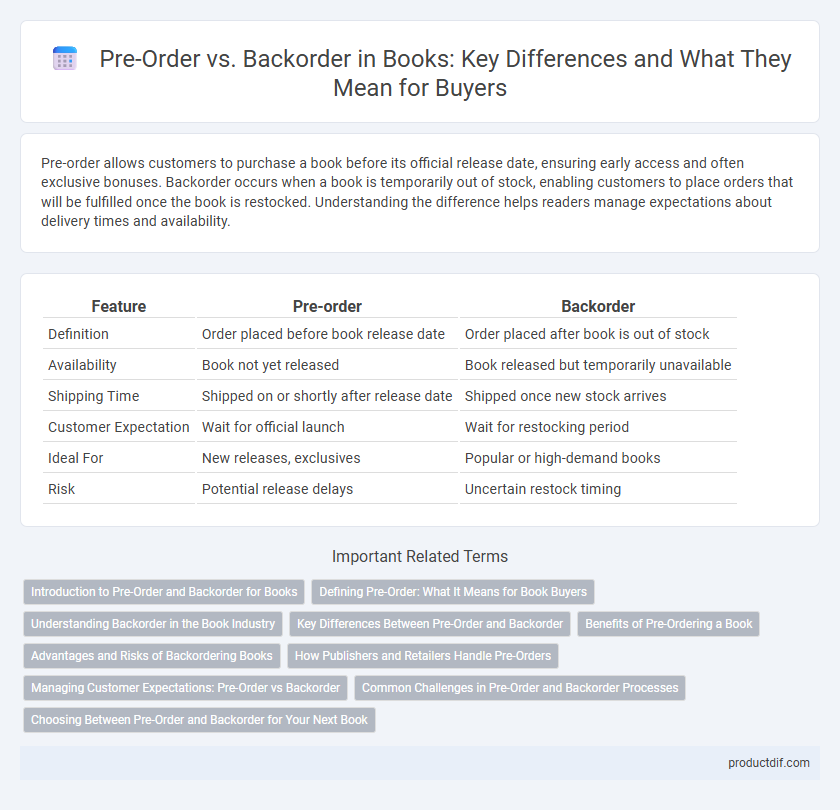Pre-order allows customers to purchase a book before its official release date, ensuring early access and often exclusive bonuses. Backorder occurs when a book is temporarily out of stock, enabling customers to place orders that will be fulfilled once the book is restocked. Understanding the difference helps readers manage expectations about delivery times and availability.
Table of Comparison
| Feature | Pre-order | Backorder |
|---|---|---|
| Definition | Order placed before book release date | Order placed after book is out of stock |
| Availability | Book not yet released | Book released but temporarily unavailable |
| Shipping Time | Shipped on or shortly after release date | Shipped once new stock arrives |
| Customer Expectation | Wait for official launch | Wait for restocking period |
| Ideal For | New releases, exclusives | Popular or high-demand books |
| Risk | Potential release delays | Uncertain restock timing |
Introduction to Pre-Order and Backorder for Books
Pre-order for books allows customers to reserve a copy before the official release date, ensuring availability on launch day and often providing exclusive bonuses or discounts. Backorder occurs when a book is temporarily out of stock but can be ordered and shipped once new inventory arrives, which may involve delayed delivery times. Understanding these terms helps readers manage expectations regarding release schedules and stock availability.
Defining Pre-Order: What It Means for Book Buyers
Pre-ordering a book allows buyers to reserve a copy before its official release date, ensuring early access and often exclusive bonuses. This process benefits readers by guaranteeing availability on launch day, especially for highly anticipated titles with limited initial print runs. Unlike backorders, pre-orders are placed prior to publication, avoiding delays associated with restocking out-of-print or sold-out books.
Understanding Backorder in the Book Industry
Backorder in the book industry occurs when a title is temporarily out of stock but still available for purchase, allowing customers to place orders that will be fulfilled once new inventory arrives. This practice helps publishers manage demand spikes and maintain sales momentum without canceling orders due to stock shortages. Understanding backorder policies ensures readers can secure popular or limited-edition books even during high-demand periods.
Key Differences Between Pre-Order and Backorder
Pre-order refers to purchasing a book before its official release date, allowing buyers to secure a copy in advance, whereas backorder occurs when a book is temporarily out of stock but orders can still be placed for future fulfillment. Pre-orders often come with exclusive bonuses or early access, while backorders involve waiting for new inventory to be restocked after high demand. The key difference lies in timing: pre-orders are for upcoming releases, and backorders address stock shortages of already released titles.
Benefits of Pre-Ordering a Book
Pre-ordering a book guarantees early access to highly anticipated releases and often includes exclusive bonuses such as signed copies, special editions, or discount pricing. This method secures a copy before the official release date, preventing stock shortages and ensuring instant delivery upon publication. Bookstores and publishers benefit from pre-orders as they provide valuable demand forecasts, enabling better inventory management and production planning.
Advantages and Risks of Backordering Books
Backordering books allows readers to secure copies of high-demand or out-of-print titles without immediate availability, ensuring eventual delivery once stock is replenished. This method reduces missed opportunities for rare or limited-edition books but carries risks like variable wait times and potential price changes before fulfillment. Customers must weigh the assurance of receiving sought-after books against uncertainties in delivery schedules and stock retention policies.
How Publishers and Retailers Handle Pre-Orders
Publishers and retailers handle pre-orders by allocating inventory based on anticipated demand, often using pre-order numbers to estimate print runs and manage supply chain logistics. Pre-orders allow publishers to gauge reader interest and secure upfront revenue, while retailers plan marketing and shelf space accordingly. In contrast, backorders occur when demand exceeds available stock, requiring publishers to produce additional copies post-release, which may delay fulfillment and impact customer satisfaction.
Managing Customer Expectations: Pre-Order vs Backorder
Pre-order allows customers to reserve a book before its official release, ensuring guaranteed availability and often earlier delivery dates, which helps manage expectations by providing clear launch timelines. Backorder occurs when a book is temporarily out of stock but will be restocked, requiring transparent communication about uncertain wait times to avoid customer dissatisfaction. Effective management of pre-orders and backorders through precise updates and realistic delivery estimates enhances customer trust and retention.
Common Challenges in Pre-Order and Backorder Processes
Common challenges in pre-order and backorder processes include managing customer expectations due to unpredictable delivery times and maintaining accurate inventory data to prevent overselling. Delays caused by supply chain disruptions or production issues frequently result in customer dissatisfaction and increased cancellation rates. Efficient communication and real-time inventory updates are critical to minimizing errors and improving the overall customer experience during pre-order and backorder fulfillment.
Choosing Between Pre-Order and Backorder for Your Next Book
Choosing between pre-order and backorder for your next book depends on availability and release timing; pre-orders guarantee a copy at the official launch date, while backorders allow purchase after stock depletion, typically with a waiting period. Pre-ordering benefits avid readers seeking immediate access upon release, leveraging promotions or exclusive editions often offered by publishers. Backorders suit those discovering popular titles post-launch, ensuring eventual delivery despite limited inventory during initial demand spikes.
Pre-order vs Backorder Infographic

 productdif.com
productdif.com